Abstract
Soil stabilization, through either physical or chemical techniques of coating-cementation development, is a commonly adopted practice in geotechnical and transportation engineering projects used to strengthen soils and mitigate negative geo-environmental impacts. This can be particularly important in enhancing the mechanical properties of soils which are prone to degradation of their response because of freezing and thawing actions. It was attempted in this research study to examine the effect of lime–zeolite stabilization on the behavior of a silt-sized natural soil of low plasticity, by performing standard compaction tests as well as unconfined compressive experiments evaluating the strength of the composite samples. The natural soil mixed with various contents of lime and zeolite partial replacement was subjected to consecutive freezing and thawing cycles. The results from the study showed significant improvement of the mechanical performance of the treated soil when mixed with lime partially replaced with zeolite in terms of strength and durability and, based on scanning electron microscopic images, additional insights were attempted to be obtained on the microstructure of the specimens subjected to temperature changes.
1. Introduction
The very complex and unpredictable behavior of clayey soils, with their widespread existence throughout the world, has created many problems in construction projects. In many cases, the natural clayey (and silty) soil available in situ may not be feasible to be used in the construction project directly due primarily to their considerably low shear strength and noticeably excessive deformations [1,2,3,4,5,6,7], or because of the expansive nature of some in situ soils [8,9,10]. Therefore, special mitigating provisions must be made for infrastructures that are to be constructed on these types of materials (generally called “problematic soils”), or in cases where the problematic soil is an available material to be used as compacted fill/backfill so as to somehow alleviate their deficiencies [11,12] and also mitigate potential undesirable maintenance costs and severe damages of infrastructures. Particularly in cold regions, the soil is frequently exposed to successive freeze–thaw cycles, i.e., a process of physical weathering that occurs in cold areas where ice forms. The characteristics of fine-grained soils, including their (micro-)structure and strength, can be affected, significantly, by consecutive freezing and thawing, which typically degrades their durability, thus posing potential risks for the long-term performance of constructed facilities. As the literature would suggest, this is a very important encountered problem in cold regions, influencing the integrity of infrastructures and structural materials [13,14,15,16,17,18,19].
Additionally, cracks, which are a common incident in clay, cause weaknesses in the soil mass, leading to a decrease in soil shear strength and an increase in soil compressibility [20]. In addition, cracks are likely to destabilize slopes [21], foundations [22], embankments [23,24], and other clay soil structures. Development of cracks may be attributed to various processes, including desiccation and shrinkage [25,26] and freezing–thawing [27].
Consecutive freezing and thawing, as a means of physical weathering, gives rise to destructive alterations in the structure of the soil and/or the aggregate causing changes in the effective stress and the water content and resulting in degradation of the soil through a process of shrinkage and swelling [28,29,30,31]. Many properties of the originally formed soil (or the engineered soil used in construction projects) may be influenced; such as the compaction characteristics, the load bearing capacity and deformability as well as its permeability characteristics, resulting often in several problems such as mud pumping and subsidence. Akagawa and Nishisato [32] proposed that when the ice pressure exceeds the tensile strength of frozen soil, fractures or cracking occurs in the soil, and such rupture of the pores in the soil is essential for the initiation of ice lenses. During the freezing and thawing cycle, when the soil voids are exposed to low temperatures, glaciers form and the water in the voids freezes which causes the water volume to increase by about 9%, leading to the formation of cracks and pores. Therefore, after the freezing and thawing cycle, scattered cracks and stability failure occur [33,34]. Mass loss in soil layers is mainly attributed to two physical processes: (i) water evaporation, and (ii) ice sublimation [35]. Evaporation of water occurs during the freezing and thawing process, while ice sublimation occurs mainly during the freezing process. When a fine-grained soil freezes at freezing point (e.g., 0 °C for pure water), not all water within the pores is frozen because of the capillarity and surface adsorption effects [36]. As the soil is continuously cooled to a specific temperature below its freezing point, the limited water inside the soil will commence to freeze, causing a significant reduction in pore water pressure and a considerably great negative pore water pressure. Suction increases moisture during the freezing process and then increases ice sublimation. Thermodynamically, according to Ozawa [37], moisture migration during soil freezing is not due primarily to mechanical force but because of the thermodynamic tendency to augment entropy inside the geo-system, which is kept in an unbalanced state. Water loss during cyclic thawing is due to water evaporation and ice sublimation. Cracking is because of the water loss and does not occur until the amount of water in the clay sample reduces to the point of soil shrinkage. Water loss is closely correlated with the thickness of the sample. To be more specific, the thinner the clay sample, the more water it loses, and thus, cracks are easily formed [38].
Wang et al. [39], based on laboratory observations, reported that the mechanical and physical properties of compacted clayey soils may change significantly, and the soil resistance may reach a minimum, and perhaps unacceptable, value after a small number of cycles of freezing and thawing (in the range of three to seven as reported in that study). In a comprehensive work conducted by Roustaei et al. [40] on fiber-reinforced fine-grained soils, the cohesion of the mixture exposed to consecutive freeze–thaw cycles was reported to significantly decrease; this behavior was attributed mainly to the development of ice lenses, which resulted in an “increased induced distance” of the grains of the soil after the completion of the freezing–thawing process. Additionally, the latter study reported the undesirable negative influence of consecutive freezing and thawing to the changes of cohesion in fine-grained soils, which could in turn be considerably alleviated by fiber reinforcing.
The use of additives and stabilizers is an effective means of improving the properties and durability of soils and thus, mitigating costs related with the physical degradation of soils, for example caused by freezing–thawing [14]. Cement and lime are known as the main chemical stabilizers, and are often used in geotechnical and transportation engineering projects to enhance the mechanical characteristics of in situ soils [9,41,42,43,44,45,46,47,48]. Based on the results of the experiments in these studies, the addition of either cement or lime to the host material was observed to significantly increase the unconfined compressive strength of the mixtures. In addition, the influence of the inclusion of another additive (such as zeolite, nano-MgO, fly ash, granulated blast furnace slag) on the strength and stiffness characteristics of the stabilized soil was carefully examined and the optimum contents of the mixture constituents, yielding the best mechanical properties, were reported. In one of the pioneering studies by Dempsey and Thompson [49], the unconfined compressive strength (UCS) value of the samples was introduced as an efficient indicator to assess the effectiveness of lime-treatment composite material by means of improved durability of the composite soil. They reported that the weight loss occurring during 12 freezing–thawing (Fr-Th) cycles, following the recommended procedures outlined in ASTM (ASTM, C593-19 [50]), could be defined as the durability of the soil stabilized with lime. Adding small amounts of lime to a subgrade soil greatly improves its resistance to freeze–thaw induced deformations, which has been found to be extremely useful in road construction projects [51,52,53]. In a separate work conducted by Boz and Sezer [54], the addition of lime to the clay was reported to improve the resistance against freeze–thaw cycles; the enhancement which is further pronounced by the addition of polypropylene fibers.
The use of additives—for example, cement or lime, as two common stabilizers—in large-scale projects is very costly and leads to negative environmental impacts caused by carbon emission during the production process [55,56,57,58,59,60]. The most recent studies have shown that cement or lime production, as an energy-intensive method, emits about 4 billion tons of CO2 into the atmosphere annually, which can cause many serious problems to the environment [55,58]. The downsides of using lime and cement have led researchers to find other alternatives, such as pozzolanic materials, as their replacement. Such materials are often used for cement and concrete production, and they contribute to the significant decrease in the required amount of lime and cement, leading to the improved mechanical properties of structural materials. A large number of works throughout the literature have reported on the enhancement of the performance of cementitious materials (e.g., concretes, cements, mortars) [61,62,63,64,65,66,67] and also of highway materials such as pavements and asphalts [68,69,70] based on pozzolanic replacements, which can also be considered as cost-effective because of their durability against sulphate and acidic actions [71,72].
Zeolite, known as a common natural pozzolan, is compositionally similar to clay minerals, but with different crystalline structure [73]. Its price is much lower than cement and lime. Zeolite particles are microporous and crystalline solids which mainly consist of SiO2 and Al2O3. Feng et al. [74] reported that these constituents react with Ca(OH)2, and as a result, the strength of the composite material significantly ameliorates. They also observed that the introduction of zeolite to the mixture decreased the porosity and increased the interfacial microstructural characteristics of the pastes, which was ascribed to the alkali-aggregate reactions. Partial replacement of the main stabilizer with zeolite causes an increase in the reaction rates, predominantly because of the elevation in the pH values, and enhances the continuation and homogeneity of the (micro-)structural characteristics of the pastes [75]. Mola-Abasi et al. [76] found that the addition of zeolite to cement–sand mixtures enhances their mechanical behavior and alters their microstructural characteristics. In several subsequent studies, the replacement of cement, partially, with zeolite by 30% (considered as an “optimum” value) provided the highest compressive and tensile strengths of cement–zeolite stabilized clay mixtures [75,76,77,78,79]. Goodarzian et al. [80] reported that the increase in nano-zeolite content increased the unconfined compressive strength; specifically, 7% nano-zeolite and 1 day of curing led to, approximately, 20% greater strength than the untreated soil. In a more recent work presented by Akbari et al. [81], it was shown that the use of lime and (nano-)zeolite up to 40% replacement, as the optimum content, improved the mechanical response of the mixture. These changes were more visible in their long-term behavior, which can give particularly promising results on the application of zeolite in terms of the serviceability period of infrastructural projects. Apart from these promising results in the application of zeolites in geotechnical and infrastructure engineering, zeolite-based materials have also been applied in numerous other applications, for example, in industrial use in coatings protecting against corrosion [82,83,84,85], broadening in this way the applications of pozzolanic materials in a wide range of areas.
With respect to applications in geotechnical engineering and ground treatment, based on the previous discussions, the significant influence of consecutive freezing and thawing cycles on the strength of lime–zeolite stabilized composite soil has not been examined systematically, particularly investigating soils with high content of silt-sized particles which, as will be explained in subsequent sections, may be prone to additional severe mechanisms of physical disintegration. To this end, in this study, the fine-grained material tested was subjected to lime treatment and partial zeolite replacement and the properties of the composite material, in terms of compaction parameters and unconfined compressive strength, were investigated by performing laboratory experiments on the mixtures that were subjected to cyclic temperature changes (i.e., freezing–thawing) which act as an “analogue” physical weathering process. The results from the study were further elaborated based on microscopic image observations from scanning electron microscope (SEM) to provide some qualitative inferences on the influence of lime-partial zeolite replacement on the (micro-)structure of soil samples subjected to mechanical disintegration.
2. Materials and Methods
2.1. Materials Used
The natural material used in the present investigation is a low plasticity soil collected from the north of Tehran, Iran. Based on consistency assessment, the material was classified as CL in accordance with the unified soil classification system (USCS), considering that the plasticity index is equal to 7.9% and the liquid limit is equal to 29.1% (note that this fine-grained material is on the border of “CL” and “CL-ML”). Table 1 and Table 2 provide the basic properties of the soil (assessed based on ASTM specifications [86,87,88,89]) as well as its composition (assessed from X-ray fluorescence analysis: XRF). The particle size distribution curve of the soil is presented in Figure 1 (note that both wet sieving and also hydrometer analysis were performed for this purpose) [89].

Table 1.
Geotechnical index properties of the original soil.

Table 2.
Chemical compositions of original soil, zeolite and lime (note: * Loss on ignition).
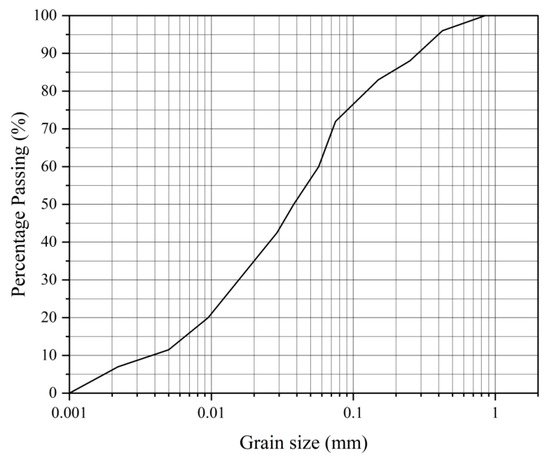
Figure 1.
Grain size distribution curve of original soil.
This fine-grained material includes, approximately, a 28% sand-sized fraction and a significant part of the fine-grained portion is assessed to be of silt size. In accordance with the literature [90], one of the important mechanisms causing mechanical (or physical) disintegration of fine-grained materials in the freeze–thaw process is called “cryosuction” (negative pressure caused by freezing of water in soil porous structure is called cryosuction). As a result, by means of capillary action, water migrates to the freezing zone through soil pores [91,92], which is prevalent in unsaturated soils. Silt-sized materials, such as the soil examined in this study, are in general more prone to the cryosuction process because of their relatively higher permeability leading to easier migration of water toward the ice lenses [90]. As the samples for the strength experiments are prepared with a small amount of water, the cryosuction process may be considered an important process on the mechanical disintegration of the treated soil in the present study, as will be discussed in the subsequent sections.
In this study, the main stabilizing agent was hydrated lime with origin from the southeastern Qazvin, Iran. The material was passed through the No.200 sieve for further process and was mixed with the original natural soil. Partial replacement of lime with zeolite was applied in the study and the zeolite, which is of the clinoptilolite type, was also passed through the No.200 sieve for further process in the composite soil–lime–zeolite mixtures. A summary of the chemical compositions of both the lime and the clinoptilolite zeolite is given in Table 2. The XRF analysis of the zeolite revealed that it consisted, predominantly, of clinoptilolite, quartz, and muscovite with some additional amount of calcite and montmorillonite.
2.2. Mixing Proportions and Sample Preparation
The host soil was stabilized adding various contents of lime (0, 2.5, 5, and 8% of the soil dry mass) and zeolite partial replacement (0, 15, 30, and 60% of lime) (Table 3 and Table 4). The experiments aimed at assessing the compaction characteristics and strength, by means of the unconfined compressive strength (UCS), of the stabilized samples. For each mixing ratio, standard Proctor tests were conducted and through these basic experiments, the maximum dry unit weight (MDUW) and optimum water content (OWC) were assessed according to the ASTM specifications (ASTM D698 [88]). To construct the composite specimens for the compaction tests, specified dry amounts of each additive were first added to the clay and thoroughly blended in order to homogenize then considering moisture content, water was added under the optimum proctor conditions (note that the amount of water increased gradually in this set of experiments), and then the constituents were thoroughly blended so as to render a fairly homogeneous mixture. Similar to this process, the samples prepared for the strength assessment were mixed with specified amounts of additives at the OWC (as specified from the compaction tests).

Table 3.
Specifications of specimens and tests conducted.

Table 4.
Mixing proportions of specimens.
It is worth noting that the measurement of water content in several prepared specimens, possessing different lime and zeolite contents, showed that the samples’ moisture slightly decreased after the process of sample preparation (roughly at about one gram for the different specimens, though this amount varied depending on the specific mixture). Therefore, one extra gram of water was added so as to compensate for the water loss during the construction of the specimens. Consecutively, similar samples with three curing times (7, 28 and 56 days) were prepared in 12 variable mixing ratios and were subjected to different numbers of freeze–thaw cycles (equal to 0, 1, 4, 8) for the strength experiments.
2.3. Testing Program and Methodology
The standard Proctor tests were conducted on all prepared samples of the lime–zeolite stabilized soils in order to examine their compaction characteristics. The mechanical response of the composite specimens was also explored by means of unconfined compressive strength (UCS) tests by preparing the specimens using static compaction inside a mold (dimensions of 50 × 100 mm). For the UCS tests, the specimens were subjected to curing durations equal to 7, 28 and 56 days at an average room temperature of 20 °C (note that the specimens remained in a room with controlled relative humidity of 95 ± 2%). After curing, the samples were subjected to 0, 1, 4 and 8 freeze–thaw cycles using a deep freezer (ASTM D560 [93]). In each cycle of freezing and thawing, the composite specimens initially remained for 24 h in the freezer with a constant temperature of −23 °C and subsequently, the thawing phase was applied at 21 °C for 23 h (after [94]).
The influence of stabilization on the durability of the specimens was assessed by measuring the weights of the stabilized samples, with 8% lime and various replacement percentages of zeolite, and after being exposed to consecutive freeze–thaw cycles (ASTM D559 [95]). To show the changes in durability as a result of the use of additives for soil treatment, the mass loss obtained by the difference in the weight of the samples before and after exposure to the F-T cycles was used [54]. A large number of tests were carried out to assess the strength of the lime–zeolite stabilized composite clayey specimens in accordance with ASTM D2166 specification [96], adopting a displacement rate of 1.05 mm/min so as to assess the impact of various numbers of freeze–thaw cycles on the strength of the mixtures after a curing times of 28 and 56 days. It is worth noting that as the long-term reactions of lime and zeolite inclusions within the microstructure of the specimens did not place completely after seven days of curing, and the freeze–thaw tests were only carried out on the samples cured for twenty-eight and fifty-six days. UCS tests were conducted on specimens with lime contents of 0%, 2.5%, 5% and 8%, and zeolite partial replacement of 0%, 15%, 30% and 60%. All the composite specimens (as well as the natural soil) were prepared at OWC (optimum water content) and MDUW (maximum dry unit weight), according to the revealed values from the compaction tests. For each sample, three replicate cylindrical specimens were tested, and the average values were recorded to assess their durability. In total, an extensive program of 324 UCS tests and 56 standard Proctor tests (taken as one sample for each water content) were performed on reconstituted specimens in order to provide some insights into the mechanical characteristics of composite soil stabilized with lime–zeolite partial replacement.
To assess the microstructural characteristics of the lime–zeolite stabilized clay samples, scanning electron microscopy (SEM: VEGA3-TESCAN model) images were taken from untreated and treated samples prepared at optimum contents of additives after 7, 28 and 56 days of curing.
3. Results and Discussion
3.1. Influence of Lime–Zeolite Stabilization on the Compaction Characteristics of the Composite Soil
Figure 2 gives a summary of the results from the compaction tests illustrating the influence of lime content (L%) and zeolite replacement percentage (Z%). For the composite specimens without zeolite partial replacement, it was noticed that as L(%) increased from 2.5% to 8%, MDUW decreased by 0.6 kN/m3 and also OWC increased by 2.8%. These results are in qualitative agreement with the studies presented in [97,98,99,100,101]. In accordance with Harichane et al. [98] and Al-Swaidani et al. [99], the reduction of MDUW and increase of OWC with lime content is mainly attributed to the pozzolanic reactions between lime and the natural soil grains in the mixture.
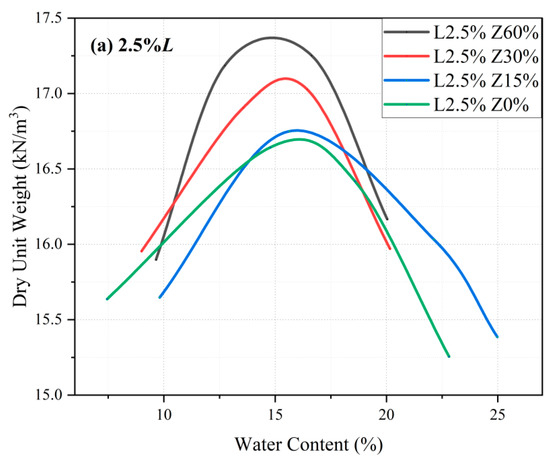
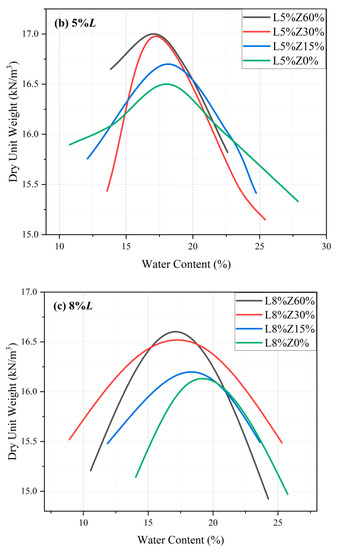
Figure 2.
Variation of dry unit weight with water content for various zeolite replacement percentages (Z%) for the samples stabilized with (a) 2.5%, (b) 5%, and (c) 8% lime content.
A representation of the chemical reactions from the addition of lime and water to the fine-grained soil is given in Equations (1) and (2).
CaO + H2O → Ca(OH)2
Ca(OH)2 → Ca2+ + 2(OH−)
The Ca2+ ion produced during the reaction of lime (containing CaO) and water leads to the cation exchanges on the surfaces of the soil microparticles. Hence, flocs are formed which in turn result in density variations [100]. Based on Al-Swaidani et al. [99], the increase of OWC with the increase in L(%) could also be attributed to the augmentation of the presence of the lighter lime in the mixture and the pozzolanic reactions between the soil microparticles.
As a portion of lime was replaced by zeolite, an increase in the density of the mixture occurred, due primarily to the higher specific gravity of solids of the zeolite compared to that of lime. With lime replacement by zeolite, the water absorption capacity and the optimum water content decreased, which could be attributed to the decrease of L(%) as an OWC incremental factor mentioned above. Moreover, the increase in zeolite content is related, predominantly, to the particle size characteristics of the mixture, which could be one of the reasons for the reduction in OWC. Ahmadi et al. [9] also reported that the very quick reactions that zeolite (as a pozzolanic material) shows when exposed to moisture cause a slight reduction in the OWC values due to the presence of zeolite.
3.2. Influence of Lime–Zeolite Stabilization on UCS of the Composite Soil
Figure 3 illustrates the stress–strain response of the composite samples with various lime and zeolite inclusions. Specifically, the influence of lime percentage and curing period for 0% of zeolite is shown in Figure 3a, while Figure 3b–d provide a comparison of the data at different zeolite replacements and curing periods for a given lime content (2.5%, 5% and 8%, respectively). For reference, the UCS test results on the untreated clay are also shown in Figure 3 corresponding to a strength of, approximately, 120 kPa and a highly ductile behavior. Based on these results, the untreated soil has an undrained shear strength of 60 kPa, thus it would be characterized as a firm clay [102].
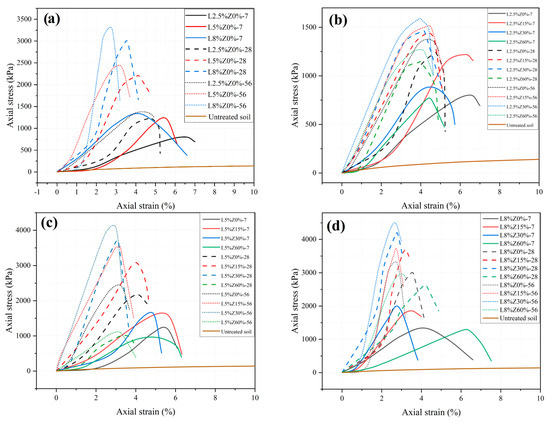
Figure 3.
Stress–strain response of (a) stabilized clay specimens with various percentages of lime without zeolite, (b) stabilized clay specimens with 2.5% lime and various percentages of zeolite, (c) stabilized clay specimens with 5% lime and various percentages of zeolite and (d) stabilized clay specimens with 8% lime and various percentages of zeolite cured for 7, 28 and 56 days.
As can be seen in this figure, for the samples without zeolite, as L(%) increases, the peak stress (unconfined strength) increases; while the axial strain at which failure occurs decreases, thus resulting in a more brittle behavior. Even for a smaller amount of lime inclusion (L = 2.5%), a significant increase of the UCS strength of, approximately, 6–7 times could be observed compared with the untreated soil. An increase of L(%) from 2.5% to 8% and also the duration of time the samples were allowed to cure from seven to twenty-eight days resulted in the enhancement of the UCS strength (increase of around four times), while the axial strain at failure dropped from 6.5% to 2.5%, approximately (Figure 3a). Similarly, for the specimens with a given lime content and at a particular curing time, as the zeolite content (Z%) in the mixture increased up to 30% of replacement, the peak stress increased and the failure strain decreased, showing again more brittle behavior. However, an opposite trend could be observed for the mixtures with the Z(%) beyond 30 percent where the UCS values dropped significantly. The data also suggest that all the specimens show a more brittle behavior with increasing curing period from 7 to 56 days. Additionally, for lower contents of lime (and lime/zeolite additives) or shorter curing periods, the curves have a softer response at their initial regime, which is commonly observed in UCS tests of untreated and/or cemented soils, giving rise to an “S” shape of the curves [58,76,77]. This shape resulted from the UCS tests is also observed for both “engineering rock” and “engineering soil” types of materials [102].
The effect of various lime contents and zeolite replacements on the unconfined compressive strength (UCS) of the composite specimens after seven, twenty-eight and fifty-six days of curing period is schematically shown in Figure 4. These data suggest that the mix with lime increases the UCS values for all the composite samples. Moreover, the partial replacement of lime with zeolite causes a further enhancement in the unconfined compressive strength of the mixtures up to Z = 30% of replacement, beyond which the trend reverses. Subsequently, 30% of zeolite replacement is considered to be the optimum content. Similar optimum percentage has been reported in several studies throughout the literature [76,77,79,81].
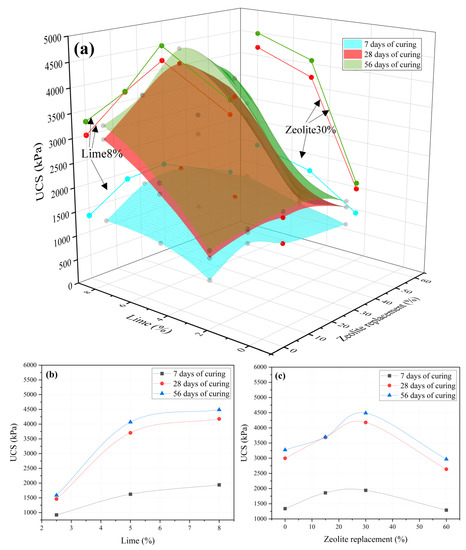
Figure 4.
Influence of lime content and zeolite partial replacement on the unconfined compressive strength (UCS) of samples cured for 7, 28 and 56 days: (a) 3D illustration of the data, (b) projection of the 3D curves: influence of lime content with 30% zeolite replacement and (c) projection of the 3D curves: influence of 8% lime content with zeolite partial replacement.
Adding lime and zeolite to the clay–water system triggers the pozzolanic reactions occurring between lime, H2O, silica, and alumina, which result in several cementitious products; for example, calcium hydrate gels with silica, or alumina are generated which fill the pore spaces among the particles and bond the adjacent grains together, altering in this way the structure of the soil and increasing its strength [103,104]. The results also suggest that the increase in curing time leads to higher strength values. According to Figure 4, it can be observed that by adding zeolite beyond 30% (as replacement), the UCS values decreased, which could be attributed to very fact that the conditions necessary for the development of calcium hydrate crystals of CSH (Calcium Silicate Hydrate) and CAH (Calcium Aluminate Hydrate) cease.
3.3. Influence of Freeze–Thaw Cycles on the Durability of Lime–Zeolite Composite Soil
Consecutive freezing and thawing (Fr-Th) negatively affects the strength and mechanical behavior of clays and in general fine-grained materials. For geo-materials subjected to successive freeze–thaw cycles, cracking is very likely to take place, where cracks, along with the outflow of water, are the main sources of the soils mass loss. The durability of the stabilized mixtures was assessed by weighting the specimens cured for 28 and 56 days before and after they were exposed to this analogue physical disintegration process (after [54]).
Figure 5 gives a summary of the results from the durability assessment for the specimens containing L = 8% and different zeolite content replacements under 1, 4 and 8 cycles of freezing and thawing. It is noticed that for a given Fr-Th cycle, the increase of L(%) in the lime-stabilized specimens led to a reduction in the amount of mass loss which agrees with reported data in the literature [105]. In addition, at a given lime content and zeolite replacement, increasing number of Fr-Th cycles triggered an increase in the maximum volume change of the lime-stabilized soil mixtures. More interestingly, the partial replacement of the lime with zeolite in the mixtures, up to the optimum content (Z = 30%), could also be observed to cause a reduction in the overall mass loss leading to enhanced durability.
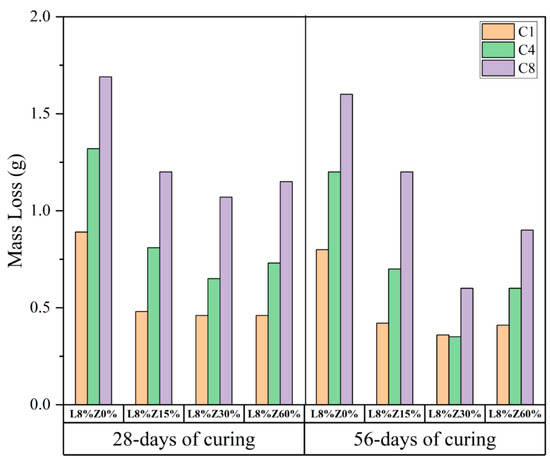
Figure 5.
Variation of mass loss of the specimens stabilized with 8% lime and various zeolite replacement percentages cured for 28 and 56 days and subjected to different numbers of consecutive freeze–thaw cycles.
It should be noted that further increase of the zeolite replacement would give rise to a slight increase in the mass loss of the mixture when subjected to Fr-Th cycles. This is aligned with the observations for the optimum Z(%) obtained from the mechanical tests. Therefore, it could be generally concluded that the addition of zeolite into the lime-stabilized soil mixtures increases their durability, thus rendering improved properties both in terms of strength (for zeolite replacements at the optimum percentage) and resistance against Fr-Th cycles. The specimens with pure lime treatment (without zeolite) had the most severe mass loss during the Fr-Th cycles, whereas the least mass loss occurred for the specimens with 8% lime and 30% zeolite replacement, which could suggest an optimum combination of lime–zeolite additives in practical projects where fine-grained materials prone to physical disintegration and temperature changes are encountered as natural (in situ) or compacted soils.
3.4. Effect of Freeze–Thaw Cycles on the UCS of Lime–Zeolite Composite Soil
Figure 6 illustrates the stress against strain curves of the composite specimens stabilized with various lime and zeolite inclusions for different curing times which were subjected to various numbers of Fr-Th cycles. The data would suggest that as the Fr-Th cycles are imposed on the stabilized soil, the peak stress (unconfined strength) decreases, whereas the axial strain corresponding to the maximum stress, i.e., at the failure state, does not follow any particular trend with the progression of the successive cycles of temperature change, observations which comply with the data reported by Güllü and Khudir [15], which worked on jute fiber, steel fiber and lime.
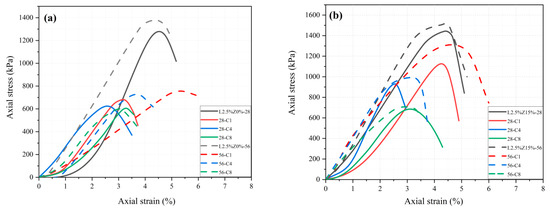
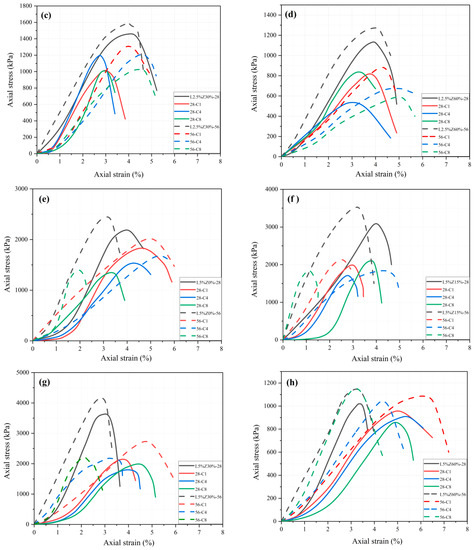
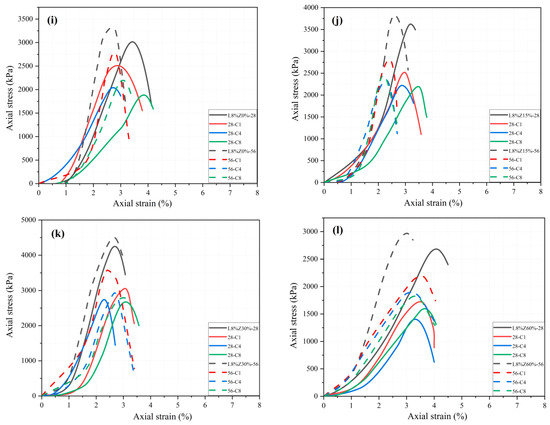
Figure 6.
Stress–strain response of (a) L2.5Z0, (b) L2.5Z15, (c) L2.5Z30, (d) L2.5Z60, (e) L5Z0, (f)L5Z15, (g) L5Z30, (h) L5Z60, (i) L8Z0, (j) L8Z15, (k) L8Z30 and (l) L8Z60 specimens cured for 28 and 56 days and the effect of freezing–thawing.
The influence of lime and zeolite partial replacement on the strength (UCS) of the composite specimens cured for twenty-eight and fifty-six days at different numbers of freeze–thaw cycles is illustrated in Figure 7. Based on this figure, the increase of Fr-Th cycles leads to a decrease of the UCS values. The UCS values of the natural (untreated) soil are observed to be quite low compared with the composite (treated) specimens. After a few freeze–thaw cycles, the original (untreated) soil had practically no resistance to shearing, which signifies the very negative influence of the freezing–thawing process on the mechanical response of silt-sized soils, which is perhaps contributed by the cryosuction process, as discussed in Section 2, leading to the magnification of the disintegration of the soil. It can be noticed that the specimens containing L = 8% and Z = 30% rendered the greatest amount of strength against successive freeze–thaw cycles. Thus, lime treatment reduced the detrimental effects of Fr-Th cycles and with the addition of zeolite (up to 30%), better outcomes were acquired. These results are exacerbated in the 56 days of curing due to the continuation of pozzolanic reactions.
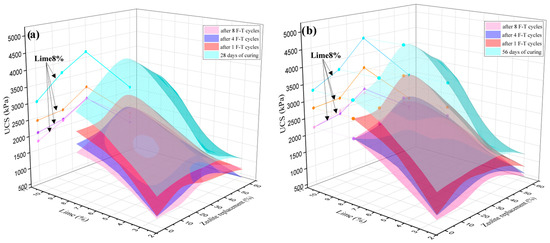
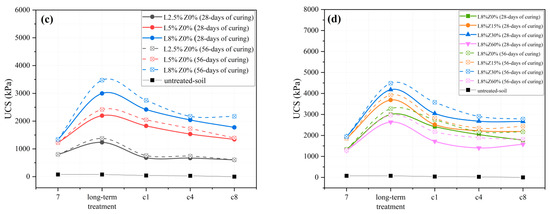
Figure 7.
Variation of unconfined compressive strength (UCS) with lime content and zeolite partial replacement for the samples cured for (a) 28 and (b) 56 days subjected different numbers of freeze–thaw cycles; variation of strength (UCS) with time for (c) samples with various lime contents without zeolite partial replacement and (d) samples with 8% lime content and different zeolite partial replacements; cured for 28 and 56 days subjected different numbers of freeze–thaw cycles.
3.5. Microstructural Analysis
We attempted to obtain additional insights based on observations from XRD and SEM images on untreated and treated samples. These SEM analyses were conducted on specimens subjected to temperature changes and the images are compared with those prior to the freeze–thaw process. Figure 8 and Figure 9 show the XRD analysis and representative SEM images of the untreated soil sample, the sample treated with 8% lime and 0% zeolite replacement, and the sample treated with 8% lime and 30% zeolite replacement (images refer to the microstructure of the specimens before the application of the freeze–thaw cycles and also after the specimens were subjected to cyclic changes of temperature). As can be seen in Figure 8, the CSH peak intensity could not be observed in the pure clay, while it can be identified for the samples L8%Z0% and L8%Z30%. This peak is more pronounced for L8%Z30%
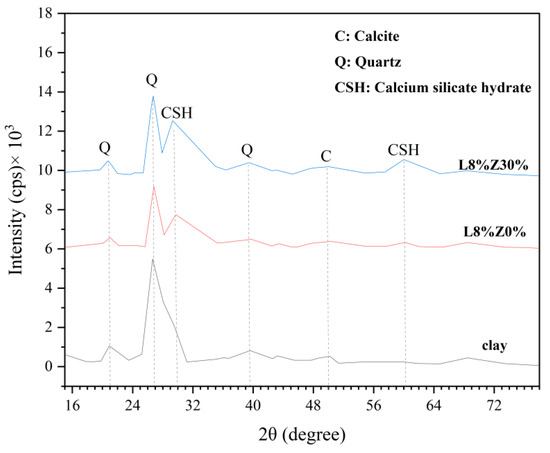
Figure 8.
XRD patterns for the clay, L8%Z0%, and L8%Z30% samples after 56 days of treatment.
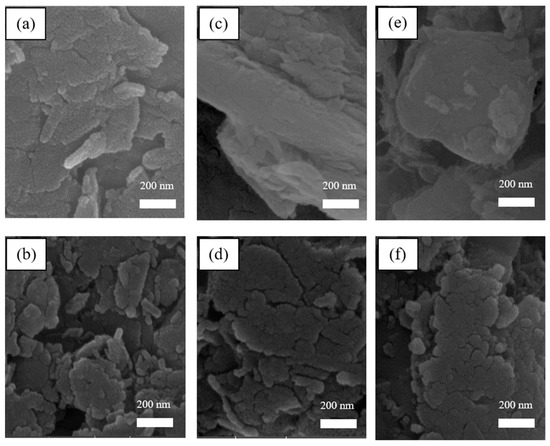
Figure 9.
SEM micrographs: (a) untreated soil before being exposed to Fr-Th cycles; (b) untreated soil after being exposed to 8 Fr-Th cycles; (c) L8%Z0% sample after 56 days of curing before being exposed to Fr-Th cycles; (d) L8%Z0% sample after 56 days of curing after being exposed to 8 Fr-Th cycles; (e) L8%Z30% after 56 days of curing before being exposed to Fr-Th cycles, (f) L8%Z30% after 56 days of curing after being exposed to 8 Fr-Th cycles.
Figure 9a shows the untreated soil with weak platy clay- to silt-sized particles and inter-particle pores. After eight freeze–thaw cycles (Figure 9b), the soil structure is significantly altered because of the development of micro-cracks which disintegrate mechanically the structure of the soil (leading as well to significant loss of the UCS strength of the material). Figure 9c,d illustrate samples containing 8% lime after 56 days of treatment. Figure 9e,f demonstrate similar cases, but for the samples with 30% zeolite replacement. As can be observed in Figure 9c,e, by adding lime or lime–zeolite to the original soil and after 56 days of curing period, the microstructure of the mixture significantly changes and turns out to be more flocculated, integrated, cohesive and with fewer pores due to the filling of cavities and coating of soil particles by calcium silicate hydrate. In other words, the voids were filled, the soil behavior was improved, and the detrimental influence of the host fine-grained soil was eliminated. Additionally, the addition of stabilizers caused the development of a secondary hydrate calcium silicate gel in the reaction between lime and zeolite, which in turn created uniform particle surfaces within the soil matrix. As a result, of these reactions, porosity and permeability remarkably decrease after stabilization. According to Figure 9d,f, as a direct result of continuous freezing and thawing, new cracks, majorly in the form of micro-cracks, within the stabilized soil mass could be recognized and the samples’ structure could be observed to be markedly disintegrated. While the freezing–thawing process mechanically alters the (micro-)structure of the untreated and composite (stabilized) soils (note that Fr-Th cycles can also significantly alter the structure of massive crystalline rocks, as suggested in the literature [19,90]), the lime/zeolite-treated soil possesses a stronger structure for the number of cycles applied in the present study, leading to a considerable remaining strength after the completion of the cyclic process of temperature changes. Thus, even though soil stabilization using lime/zeolite is itself advantageous in terms of improvement of the mechanical properties of soil as well as its durability, this can be particularly critical in clays and silts which are subjected to cyclic changes of temperature, where the strength of the untreated soil drops significantly due primarily to the development of microcracks, whereas the stabilized soil maintains some significant amount of strength through the remaining developed bonds.
4. Concluding Remarks
The influence of lime–zeolite stabilization on the mechanical response of a natural soil (classified as clay even though it contained significant portion of silt-sized particles) subjected to freeze–thaw cycles (considered as an analogue physical weathering process) was thoroughly examined in the study through unconfined compressive strength tests. Additional experiments were carried out based on standard Proctor tests to evaluate the compaction characteristics of the composite material with varying lime and zeolite contents. The soil was mixed with lime contents (L%) of 0%, 2.5%, 5% and 8%, and zeolite partial replacement (Z%) of 0%, 15%, 30% and 60% and the specimens were cured for seven, twenty-eight and fifty-six days. The partial replacement of lime with zeolite enhanced the stabilization process. Please note that as the soil in this study included a significant amount of silt-sized particles, based on the hydrometer analysis, the influence of cryosuction as a mechanical process of disintegration of the soil may be magnified. The following major conclusions were drawn:
- For the lime-stabilized specimens (Z = 0%), the increase in the lime content made the specimens lighter (i.e., their maximum dry unit weight, MDUW, values decreased by 0.6 kN/m3) and their optimum water content (OWC) increased by 2.8%). The addition of zeolite to the composite soil, as a means of partial replacement of the lime, was observed to cause a reduction in OWC and the increase in MDUW, but zeolite also increased the capacity of the specimens to absorb water.
- The addition of lime led to the increase in the UCS values of the composite samples. Moreover, the partial replacement of lime with zeolite caused a further increase in the strength of the mixtures up to 30% (which was considered as the optimum zeolite replacement), beyond which it decreased.
- The incorporation of lime and zeolite, up to the optimum content, into the tested soils was concluded to result in higher durability of the mixture, which was translated in smaller amount of mass loss occurred for the specimens with L = 8% and Z = 30%.
- The UCS values of the composite samples (treated with lime–zeolite) decreased with increasing number of freeze–thaw cycles. The lime–zeolite composite material had better durability to the freezing–thawing process compared to the untreated natural soil. The samples with L = 8% and Z = 30% rendered the greatest amount of strength against temperature changes. These observations were exacerbated in the 56-days of curing due to the continuation of pozzolanic reactions.
Author Contributions
S.S.: Conceptualization, performing experiments, data analysis, writing the first draft. S.G.J.: Conceptualization, data analysis, supervision. M.P.: Conceptualization, data analysis, supervision, revising the manuscript. K.S.: Conceptualization, data analysis, supervision, revising the manuscript. All authors have read and agreed to the published version of the manuscript.
Funding
The work was supported by GRF grants, project no. “CityU 11214218” and project no. “CityU 11210419” from the Research Grants Council of the Hong Kong Special Administrative Region, China, and the DON project no. “9220117”.
Institutional Review Board Statement
Not applicable.
Informed Consent Statement
Not applicable.
Data Availability Statement
Data are available by the corresponding author after reasonable request.
Conflicts of Interest
The authors declare no conflict of interest.
References
- Phanikumar, B.R.; Nagaraju, T.V. Effect of fly ash and rice husk ash on index and engineering properties of expansive clays. Geotech. Geol. Eng. 2018, 36, 3425–3436. [Google Scholar] [CrossRef]
- Vakili, A.H.; Ghasemi, J.; bin Selamat, M.R.; Salimi, M.; Farhadi, M.S. Internal erosional behaviour of dispersive clay stabilized with lignosulfonate and reinforced with polypropylene fiber. Constr. Build. Mater. 2018, 193, 405–415. [Google Scholar] [CrossRef]
- Vakili, A.H.; Selamat, M.R.; Salimi, M.; Gararei, S.G. Evaluation of pozzolanic portland cement as geotechnical stabilizer of a dispersive clay. Int. J. Geotech. Eng. 2021, 15, 504–511. [Google Scholar] [CrossRef]
- Jayapal, J.; Rajagopal, K. A short review of geosynthetic granular column treatment of soft clay soils. Ground Improv. Tech. Geosynth. 2019, 373–380. [Google Scholar] [CrossRef]
- Onyelowe, K.C. Review on the role of solid waste materials in soft soils reengineering. Mater. Sci. Energy Technol. 2019, 2, 46–51. [Google Scholar] [CrossRef]
- Kherad, M.K.; Vakili, A.H.; bin Selamat, M.R.; Salimi, M.; Farhadi, M.S.; Dezh, M. An experimental evaluation of electroosmosis treatment effect on the mechanical and chemical behavior of expansive soils. Arab. J. Geosci. 2020, 13, 1–2. [Google Scholar] [CrossRef]
- Afrasiabian, A.; Salimi, M.; Movahedrad, M.; Vakili, A.H. Assessing the impact of GBFS on mechanical behaviour and microstructure of soft clay. Int. J. Geotech. Eng. 2021, 15, 327–337. [Google Scholar] [CrossRef]
- Khadka, S.D.; Jayawickrama, P.W.; Senadheera, S.; Segvic, B. Stabilization of highly expansive soils containing sulfate using metakaolin and fly ash based geopolymer modified with lime and gypsum. Transp. Geotech. 2020, 23, 100327. [Google Scholar] [CrossRef]
- Chenarboni, H.A.; Lajevardi, S.H.; MolaAbasi, H.; Zeighami, E. The effect of zeolite and cement stabilization on the mechanical behavior of expansive soils. Constr. Build. Mater. 2021, 272, 121630. [Google Scholar] [CrossRef]
- Tiwari, N.; Satyam, N.; Puppala, A.J. Strength and durability assessment of expansive soil stabilized with recycled ash and natural fibers. Transp. Geotech. 2021, 29, 100556. [Google Scholar] [CrossRef]
- Khajeh, A.; Chenari, R.J.; Payan, M. A simple review of cemented non-conventional materials: Soil composites. Geotech. Geol. Eng. 2020, 38, 1019–1040. [Google Scholar] [CrossRef]
- Fernández, M.T.; Orlandi, S.; Codevilla, M.; Piqué, T.M.; Manzanal, D. Performance of calcium lignosulfonate as a stabiliser of highly expansive clay. Transp. Geotech. 2021, 27, 100469. [Google Scholar] [CrossRef]
- Paige-Green, P. The durability of stabilized materials. In Proceedings of the 12th International Conference of International Association for Computer Methods and Advances in Geomechanics (IACMAG), Goa, India, 1–6 October 2008; pp. 1–6. [Google Scholar]
- Liu, J.; Wang, T.; Tian, Y. Experimental study of the dynamic properties of cement-and lime-modified clay soils subjected to freeze–thaw cycles. Cold Reg. Sci. Technol. 2010, 61, 29–33. [Google Scholar] [CrossRef]
- Güllü, H.; Khudir, A. Effect of freeze–thaw cycles on unconfined compressive strength of fine-grained soil treated with jute fiber, steel fiber and lime. Cold Reg. Sci. Technol. 2014, 106, 55–65. [Google Scholar] [CrossRef]
- Ahmadi, S.; Ghasemzadeh, H.; Changizi, F. Effects of A Low-Carbon Emission Additive on Mechanical Properties of Fine-grained Soil under Freeze-Thaw Cycles. J. Cleaner Prod. 2021, 304, 127157. [Google Scholar] [CrossRef]
- Hong, X.; Wang, H.; Shi, F. Influence of NaCl freeze thaw cycles and cyclic loading on the mechanical performance and permeability of sulphoaluminate cement reactive powder concrete. Coatings 2020, 10, 1227. [Google Scholar] [CrossRef]
- Guo, W.; Guo, X.; Li, Y.; Dai, W. laboratory investigation on physical, rheological thermal and microscopic characteristics of water-foamed asphalt under three environmental conditions. Coatings 2020, 10, 239. [Google Scholar] [CrossRef] [Green Version]
- Grotzinger, J.P.; Jordan, T.H. Understanding Earth, 7th ed.; W.H. Freeman and Company: New York, NY, USA, 2014. [Google Scholar]
- Saada, A.S.; Bianchini, G.F.; Liang, L. Cracks, bifurcation and shear bands propagation in saturated clays. Geotechnique 1994, 44, 35–64. [Google Scholar] [CrossRef]
- Gao, Y.; Song, W.; Zhang, F.; Qin, H. Limit analysis of slopeswith cracks: Comparisons of results. Eng. Geol. 2015, 188, 97–100. [Google Scholar] [CrossRef]
- Lozada, C.; Caicedo, B.; Thorel, L. Effects of cracks and desiccation on the bearing capacity of soil deposits. Géotech. Lett. 2015, 5, 112–117. [Google Scholar] [CrossRef]
- Spencer, E. Effect of tension on stability of embankments. J. Soil Mech. Found. Div. 1968, 94, 1159–1176. [Google Scholar] [CrossRef]
- Dyer, M.; Utili, S.; Zielinski, M. Field survey of desiccation fissuring of flood embankments. Proc. ICE Water Manag. 2009, 162, 221–232. [Google Scholar] [CrossRef]
- Yesiller NMiller, C.J.; Inci, G.; Yaldo, K. Desiccation and cracking behavior of three compacted landfill liner soils. Eng. Geol. 2000, 57, 105–121. [Google Scholar] [CrossRef] [Green Version]
- Tang, C.; Shi, B.; Liu, C.; Zhao, L.; Wang, B. Influencing factors of geometrical structure of surface shrinkage cracks in clayey soils. Eng. Geol. 2008, 101, 204–217. [Google Scholar] [CrossRef]
- Chamberlain, E.J.; Gow, A.J. Effect of freezing and thawing on the permeability and structure of soils. Eng. Geol. 1979, 13, 73–92. [Google Scholar] [CrossRef]
- Zhang, Z.; Wei, M.A.; Feng, W.; Xiao, D.; Hou, X. Reconstruction of soil particle composition during freeze-thaw cycling: A review. Pedosphere 2016, 26, 167–179. [Google Scholar] [CrossRef]
- Zhang, Y.; Johnson, A.E.; White, D.J. Freeze-thaw performance of cement and fly ash stabilized loess. Transp. Geotech. 2019, 21, 100279. [Google Scholar] [CrossRef]
- Wang, S.; Yang, Z.J.; Yang, P. Structural change and volumetric shrinkage of clay due to freeze-thaw by 3D X-ray computed tomography. Cold Reg. Sci. Technol. 2017, 138, 108–116. [Google Scholar] [CrossRef]
- Roghani, A. Quantifying the effect of freeze-thaw cycles on track surface deformation and degradation of railway track geometry; Case study. Transp. Geotech. 2021, 30, 100601. [Google Scholar] [CrossRef]
- Akagawa, S.; Nishisato, K. Tensile strength of frozen soil in the temperature range of the frozen fringe. Cold Reg. Sci. Technol. 2009, 57, 13–22. [Google Scholar] [CrossRef] [Green Version]
- Yıldız, M.; Soğancı, A.S. Effect of freezing and thawing on strength and permeability of lime-stabilized clays. Sci. Iran. 2012, 19, 1013–1017. [Google Scholar] [CrossRef] [Green Version]
- Altun, S.; Sezer, A.; Erol, A. The effects of additives and curing conditions on the mechanical behavior of a silty soil. Cold Reg. Sci. Technol. 2009, 56, 135–140. [Google Scholar] [CrossRef]
- Jong, E.D.; Kachanoski, R.G. Drying of frozen soils. Can. J. Soil Sci. 1988, 68, 807–811. [Google Scholar] [CrossRef]
- Morgenstern, N.R.; Anderson, D.M. Physics, chemistry, and mechanics of frozen ground: A review. In Permafrost: North American Contribution [to The] Second International Conference; National Academies: Washington, DC, USA, 1973; Volume 2, p. 257. [Google Scholar]
- Ozawa, H. Thermodynamics of frost heaving: A thermodynamic proposition for dynamic phenomena. Phys. Rev. E 1997, 56, 2811. [Google Scholar] [CrossRef]
- Lu, Y.; Liu, S.; Weng, L.; Wang, L.; Li, Z.; Xu, L. Fractal analysis of cracking in a clayey soil under freeze–thaw cycles. Eng. Geol. 2016, 208, 93–99. [Google Scholar] [CrossRef]
- Wang, D.Y.; Ma, W.; Niu, Y.H.; Chang, X.X.; Wen, Z. Effects of cyclic freezing and thawing on mechanical properties of Qinghai–Tibet clay. Cold Reg. Sci. Technol. 2007, 48, 34–43. [Google Scholar] [CrossRef]
- Roustaei, M.; Eslami, A.; Ghazavi, M. Effects of freeze–thaw cycles on a fiber reinforced fine grained soil in relation to geotechnical parameters. Cold Reg. Sci. Technol. 2015, 120, 127–137. [Google Scholar] [CrossRef]
- Ingles, O.G.; Metcalf, J.B. Soil Stabilization Principles and Practice; Butterworth and Company Publishers Limited: London, UK; Transport and Road Research Laboratory: Crowthorne, UK; Transportation Research Board: Washington, DC, USA, 1972; Volume 11. [Google Scholar]
- Sharma, N.K.; Swain, S.K.; Sahoo, U.C. Stabilization of a clayey soil with fly ash and lime: A micro level investigation. Geotech. Geol. Eng. 2012, 30, 1197–1205. [Google Scholar] [CrossRef]
- Koohpeyma, H.R.; Vakili, A.H.; Moayedi, H.; Panjsetooni, A.; Nazir, R. Investigating the effect of lignosulfonate on erosion rate of the embankments constructed with clayey sand. Sci. World J. 2013, 2013, 587462. [Google Scholar] [CrossRef] [PubMed]
- Yi, Y.; Zheng, X.; Liu, S.; Al-Tabbaa, A. Comparison of reactive magnesia-and carbide slag-activated ground granulated blastfurnace slag and Portland cement for stabilisation of a natural soil. Appl. Clay Sci. 2015, 111, 21–26. [Google Scholar] [CrossRef]
- Phetchuay, C.; Horpibulsuk, S.; Arulrajah, A.; Suksiripattanapong, C.; Udomchai, A. Strength development in soft marine clay stabilized by fly ash and calcium carbide residue based geopolymer. Appl. Clay Sci. 2016, 127, 134–142. [Google Scholar] [CrossRef]
- Yaghoubi, M.; Arulrajah, A.; Disfani, M.M.; Horpibulsuk, S.; Bo, M.W.; Darmawan, S. Effects of industrial by-product based geopolymers on the strength development of a soft soil. Soils Found. 2018, 58, 716–728. [Google Scholar] [CrossRef]
- Yao, K.; Wang, W.; Li, N.; Zhang, C.; Wang, L. Investigation on strength and microstructure characteristics of nano-MgO admixed with cemented soft soil. Constr. Build. Mater. 2019, 206, 160–168. [Google Scholar] [CrossRef]
- MolaAbasi, H.; Khajeh, A.; Semsani, S.N.; Kordnaeij, A. Prediction of zeolite-cemented sand tensile strength by GMDH type neural network. J. Adhes. Sci. Technol. 2019, 33, 1611–1625. [Google Scholar] [CrossRef]
- Dempsey, B.J.; Thompson, M.R. Vacuum Saturation Method for Predicting Freeze-Thaw Durability of Stabilized Materials; Transportation Research Board: Washington, DC, USA, 1973. [Google Scholar]
- ASTM C593-19. Standard Specification for Fly Ash and Other Pozzolans for Use with Lime for Soil Stabilization; ASTM International: West Conshohocken, PA, USA, 2019. [Google Scholar]
- Sauer, E.K.; Weimer, N.F. Deformation of lime modified clay after freeze-thaw. Transp. Eng. J. ASCE 1978, 104, 201–212. [Google Scholar] [CrossRef]
- Tebaldi, G.; Orazi, M.; Orazi, U.S. Effect of freeze—Thaw cycles on mechanical behavior of lime-stabilized soil. J. Mater. Civ. Eng. 2016, 28, 06016002. [Google Scholar] [CrossRef]
- Saygili, A.; Dayan, M. Freeze-thaw behavior of lime stabilized clay reinforced with silica fume and synthetic fibers. Cold Reg. Sci. Technol. 2019, 161, 107–114. [Google Scholar] [CrossRef]
- Boz, A.; Sezer, A. Influence of fiber type and content on freeze-thaw resistance of fiber reinforced lime stabilized clay. Cold Reg. Sci. Technol. 2018, 151, 359–366. [Google Scholar] [CrossRef]
- Yusuf, M.O.; Johari, M.A.M.; Ahmad, Z.A.; Maslehuddin, M. Strength and microstructure of alkali-activated binary blended binder containing palm oil fuel ash and ground blast-furnace slag. Constr. Build. Mater. 2014, 52, 504–510. [Google Scholar] [CrossRef]
- Goodarzi, A.R.; Akbari, H.R.; Salimi, M. Enhanced stabilization of highly expansive clays by mixing cement and silica fume. Appl. Clay Sci. 2016, 132, 675–684. [Google Scholar] [CrossRef]
- Salimi, M.; Ilkhani, M.; Vakili, A.H. Stabilization treatment of Na-montmorillonite with binary mixtures of lime and steelmaking slag. Int. J. Geotech. Eng. 2020, 14, 295–301. [Google Scholar] [CrossRef]
- Salimi, M.; Ghorbani, A. Mechanical and compressibility characteristics of a soft clay stabilized by slag-based mixtures and geopolymers. Appl. Clay Sci. 2020, 184, 105390. [Google Scholar] [CrossRef]
- Samarakoon, M.H.; Ranjith, P.G.; Rathnaweera, T.D.; Perera, M.S.A. Recent advances in alkaline cement binders: A review. J. Clean. Prod. 2019, 227, 70–87. [Google Scholar] [CrossRef]
- Amran, Y.M.; Alyousef, R.; Alabduljabbar, H.; El-Zeadani, M. Clean production and properties of geopolymer concrete; A review. J. Clean. Prod. 2020, 251, 119679. [Google Scholar] [CrossRef]
- Chen, J.J.; Li, L.G.; Ng, P.L.; Kwan, A.K.H. Effects of superfine zeolite on strength, flowability and cohesiveness of cementitious paste. Cem. Concr. Compos. 2017, 83, 101–110. [Google Scholar] [CrossRef]
- Burris, L.; Juenger, M.C.G. Effect of calcination on the reactivity of natural clinoptilolite zeolites used as supplementary cementitious materials. Constr. Build. Mater. 2020, 258, 119988. [Google Scholar] [CrossRef]
- Wang, Q.; Zhang, J.; Ho, J.C.M. Zeolite to improve strength-shrinkage performance of high-strength engineered cementitious composite. Constr. Build. Mater. 2020, 234, 117335. [Google Scholar] [CrossRef]
- Faheem, A.; Ali Rizwan, S.; Bier, T.A. Properties of self-compacting mortars using blends of limestone powder, fly ash, and zeolite powder. Constr. Build. Mater. 2021, 286, 122788. [Google Scholar] [CrossRef]
- Kushnir, A.R.L.; Heap, M.J.; Griffiths, L.; Wadsworth, F.B.; Langella, A.; Baud, P.; Reuschlé, T.; Kendrick, J.E.; Utley, J.E.P. The fire resistance of high-strength concrete containing natural zeolites. Cem. Concr. Compos. 2021, 116, 103897. [Google Scholar] [CrossRef]
- Zheng, X.; Zhang, J.; Ding, X.; Chu, H.; Zhang, J. Frost resistance of internal curing concrete with calcined natural zeolite particles. Constr. Build. Mater. 2021, 288, 123062. [Google Scholar] [CrossRef]
- Ravazi, S.M.; Nazarpour, H.; Beygi, M.H. Investigation of the efficacy of nano-silica on mechanical properties of Green-Engineered Cementitious Composite (GECC) containing high volume natural zeolite. Constr. Build. Mater. 2021, 291, 123246. [Google Scholar]
- Han, X.; Cao, Z.; Wang, R.; He, P.; Zhang, Y.; Yu, J.; Ge, Y. Effect of silane coupling agent modified zeolite warm mix additives on properties of asphalt. Constr. Build. Mater. 2020, 259, 119713. [Google Scholar] [CrossRef]
- Hamzani; Munirwansyh; Hasan, M.; Sugiarto, S. Determining the properties of semi-flexible pavement using waste tire rubber powder and natural zeolite. Constr. Build. Mater. 2021, 266, 121199. [Google Scholar] [CrossRef]
- Zhang, X.; Xiao, Y.; Long, Y.; Chen, Z.; Cui, P.; Wu, R.; Chang, X. VOCs reduction in bitumen binder with optimally designed Ca(OH)2-incorporated zeolite. Constr. Build. Mater. 2021, 279, 122485. [Google Scholar] [CrossRef]
- Rahgozar, M.A.; Saberian, M.; Li, J. Soil stabilization with non-conventional eco-friendly agricultural waste materials: An experimental study. Transp. Geotech. 2018, 14, 52–60. [Google Scholar] [CrossRef]
- Saberian, M.; Moradi, M.; Vali, R.; Li, J. Stabilized marine and desert sands with deep mixing of cement and sodium bentonite. Geomech. Eng. 2018, 14, 553–562. [Google Scholar]
- Perraki, T.; Kakali, G.; Kontoleon, F. The effect of natural zeolites on the early hydration of Portland cement. Microporous Mesoporous Mater. 2003, 61, 205–212. [Google Scholar] [CrossRef]
- Feng, N.Q.; Li, G.Z.; Zang, X.W. High-strength and flowing concrete with a zeolitic mineral admixture. Cem. Concr. Aggreg. 1990, 12, 61–69. [Google Scholar]
- Mola-Abasi, H.; Khajeh, A.; Naderi Semsani, S. Variables controlling tensile strength of stabilized sand with cement and zeolite. J. Adhes. Sci. Technol. 2018, 32, 947–962. [Google Scholar] [CrossRef]
- Mola-Abasi, H.; Kordtabar, B.; Kordnaeij, A. Effect of natural zeolite and cement additive on the strength of sand. Geotech. Geol. Eng. 2016, 34, 1539–1551. [Google Scholar] [CrossRef]
- Mola-Abasi, H.; Shooshpasha, I. Influence of zeolite and cement additions on mechanical behavior of sandy soil. J. Rock Mech. Geotech. Eng. 2016, 8, 746–752. [Google Scholar] [CrossRef] [Green Version]
- MolaAbasi, H. Evaluation of zeolite effect on strength of babolsar sand stabilized with cement using unconfined compression test. Modares Civ. Eng. J. 2017, 16, 203–213. [Google Scholar]
- Khajeh, A.; MolaAbasi, H.; Naderi Semsani, S. Tensile strength parameters controlling of zeolite-cemented sands. Sci. Iran. 2019, 26, 213–223. [Google Scholar] [CrossRef] [Green Version]
- Goodarzian, A.; Ghasemipanah, A.; Moayed, R.Z.; Niroumand, H. Influence of nanozeolite particles on improvement of clayey soil. Int. J. Geotech. Geol. Eng. 2020, 14, 40–48. [Google Scholar]
- Akbari, H.R.; Sharafi, H.; Goodarzi, A.R. Effect of polypropylene fiber inclusion in kaolin clay stabilized with lime and nano-zeolite considering temperatures of 20 and 40 °C. Bull. Eng. Geol. Environ. 2021, 80, 1841–1855. [Google Scholar] [CrossRef]
- Cai, R.; Yan, Y. Corrosion-resistant zeolite coatings. Corrosion 2008, 64, 271–278. [Google Scholar] [CrossRef]
- Calabrese, L. Anticorrosion behavior of zeolite coatings obtained by in situ crystallization: A critical review. Materials 2018, 12, 59. [Google Scholar] [CrossRef] [Green Version]
- Javierre, E. Modeling self-healing mechanisms in coatings: Approaches and perspectives. Coatings 2019, 9, 122. [Google Scholar] [CrossRef] [Green Version]
- Calabrese, L.; Proverbio, E. A Brief Overview on the Anticorrosion Performances of Sol-Gel Zeolite Coatings. Coatings 2019, 9, 409. [Google Scholar] [CrossRef] [Green Version]
- ASTM D854-14. Standard Test Methods for Specific Gravity of Soil Solids by Water Pycnometer; ASTM International: West Conshohocken, PA, USA, 2014. [Google Scholar]
- ASTM D4318-17e1. Standard Test Methods for Liquid Limit, Plastic Limit, and Plasticity Index of Soils; ASTM International: West Conshohocken, PA, USA, 2017. [Google Scholar]
- ASTM D698-12e2. Standard Test Methods for Laboratory Compaction Characteristics of Soil Using Standard Effort (12 400 ft-lbf/ft3 (600 kN-m/m3)); ASTM International: West Conshohocken, PA, USA, 2012. [Google Scholar]
- ASTM D2487-17e1. Standard Practice for Classification of Soils for Engineering Purposes (Unified Soil Classification System); ASTM International: West Conshohocken, PA, USA, 2017. [Google Scholar]
- Parriaux, A. Geology: Basics for Engineers; CRC Press, Taylor and Francis Group: Oxon, UK, 2009. [Google Scholar]
- Williams, P.J.; Smith, M.W. The Frozen Earth: Fundamentals of Geocryology; Cambridge University Press: Cambridge, UK, 1989; Volume 306. [Google Scholar]
- Hohmann, M. Soil freezing—The concept of soil water potential. State of the art. Cold Reg. Sci. Technol. 1997, 25, 101–110. [Google Scholar] [CrossRef]
- ASTM D560/D560M-16. Standard Test Methods for Freezing and Thawing Compacted Soil-Cement Mixtures; ASTM International: West Conshohocken, PA, USA, 2016. [Google Scholar]
- Hotineanu, A.; Bouasker, M.; Aldaood, A.; Al-Mukhtar, M. Effect of freeze–thaw cycling on the mechanical properties of lime-stabilized expansive clays. Cold Reg. Sci. Technol. 2015, 119, 151–157. [Google Scholar] [CrossRef]
- ASTM D559/D559M-15. Standard Test Methods for Wetting and Drying Compacted Soil-Cement Mixtures; ASTM International: West Conshohocken, PA, USA, 2015. [Google Scholar]
- ASTM D2166/D2166M-16. Standard Test Method for Unconfined Compressive Strength of Cohesive Soil; ASTM International: West Conshohocken, PA, USA, 2016. [Google Scholar]
- Ramlakhan, B.; Kumar, S.A.; Arora, T.R. Effect of lime and fly ash on engineering properties of black cotton soil. Int. J. Emerg. Technol. Adv. Eng. 2013, 3, 535–541. [Google Scholar]
- Harichane, K.; Ghrici, M.; Kenai, S.; Grine, K. Use of natural pozzolana and lime for stabilization of cohesive soils. Geotech. Geol. Eng. 2011, 29, 759–769. [Google Scholar] [CrossRef]
- Al-Swaidani, A.; Hammoud, I.; Meziab, A. Effect of adding natural pozzolana on geotechnical properties of lime-stabilized clayey soil. J. Rock Mech. Geotech. Eng. 2016, 8, 714–725. [Google Scholar] [CrossRef] [Green Version]
- Ikeagwuani, C.C.; Obeta, I.N.; Agunwamba, J.C. Stabilization of black cotton soil subgrade using sawdust ash and lime. Soils Found. 2019, 59, 162–175. [Google Scholar] [CrossRef]
- Islam, S.; Hoque, N.R.; Haque, M.A.; Mishra, P.N.; Mamun, M.M.H.; Dey, S. Strength development in fine-grained paddy field soil by lime addition. J. Build. Eng. 2019, 26, 100857. [Google Scholar] [CrossRef]
- González de Vallejo, L.I.; Ferrer, M. Geological Engineering; CRC Press, Taylor & Francis Group: London, UK, 2011. [Google Scholar]
- Terrel, R.L.; Epps, J.A.; Barenberg, E.J.; Mitchell, J.K.; Thompson, M.R. Soil Stabilization in Pavement Structures: A User’s Manual; Federal Highway Administration (FHWA), US Department of Transportation: Washington, DC, USA, 1979; Volume 1.
- Mallela, J.; Quintus, H.V.; Smith, K. Consideration of lime-stabilized layers in mechanistic-empirical pavement design. Nat. Lime Assoc. 2004, 200, 1–40. [Google Scholar]
- Aldaood, A.; Bouasker, M.; Al-Mukhtar, M. Impact of freeze–thaw cycles on mechanical behaviour of lime stabilized gypseous soils. Cold Reg. Sci. Technol. 2014, 99, 38–45. [Google Scholar] [CrossRef]
Publisher’s Note: MDPI stays neutral with regard to jurisdictional claims in published maps and institutional affiliations. |
© 2021 by the authors. Licensee MDPI, Basel, Switzerland. This article is an open access article distributed under the terms and conditions of the Creative Commons Attribution (CC BY) license (https://creativecommons.org/licenses/by/4.0/).